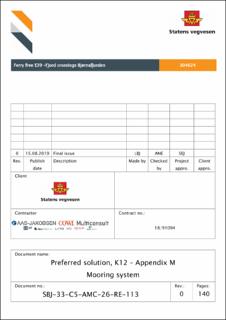| dc.contributor.author | Statens vegvesen | |
| dc.contributor.author | LBJ | |
| dc.coverage.spatial | Norway, E39 Bjørnafjorden | en_US |
| dc.date.accessioned | 2020-06-29T09:51:49Z | |
| dc.date.available | 2020-06-29T09:51:49Z | |
| dc.date.issued | 2019-08-15 | |
| dc.identifier.uri | https://hdl.handle.net/11250/2659829 | |
| dc.description.abstract | A mooring system has been developed to support the floating bridge concept for crossing Bjørnafjorden.
The curved bridge concept has three moored pontoons relatively close to the center with four mooring lines each, giving a total of 12 mooring lines anchored to the seabed. All anchors are suction anchors located on a relatively flat seabed with sufficient seabed soil for installation and stability.
All components of the mooring system are well known the offshore industry. Four dual axis fairleads are installed on the three moored pontoons. The fairleads will reduce any chain bending moments on the top end of the mooring chain. The fairleads are installed close to the bottom of the moored pontoons. This is done to reduce corrosion on the top end mooring chain and to avoid damage from ship collision.
The mooring lines have R4 chain and 124 mm coated steel wire ropes. All lines have 50 m top chain between fairlead connection on the pontoon and the wire rope segment. All lines have 100 m bottom chain between the wire rope segment and the anchor. Mooring line pretension has been optimized to give the desired line pretension or transverse restoring stiffness for each pontoon. The mooring line tension will also provide minimal total enforced loads from the mooring lines on each pontoon during equilibrium bridge position in calm weather. The mooring lines are pretensioned to 1.9-2.6 MN, providing a relatively taut system where the bottom chain most of the time will be suspended and not lay on the seabed.
Anchors locations are found to suit both a symmetrical mooring spread and locations on seabed with acceptable condition such as seabed slope, stability and soil thickness. Anchor positions are based on anchor suitability maps and recommendations from NGI based on the same geotechnical data. All anchors are located between 360 and 560 m water depth on relatively flat parts of the seabed. All anchors also have an alternative identified location close to the original location as a backup. Detailed anchor calculations and geotechnical evaluations are enclosed at the end of the appendix.
The mooring system design life will be 100 years. All components will either be replaced or have 100 year fatigue life. Top chain and steel wires should be replaced once, thus having 50 years fatigue life. All other mooring system components will have at least 100 year fatigue life.
Mooring calculations has been performed for worst intact condition, after multiple line breaks, during ship collision and fatigue life of mooring lines. All mooring lines satisfy the given requirements to loads and fatigue life.
The suggested mooring system is found to satisfy the requirements of rules and regulations using standard proven components from the offshore industry. More work on dimensions or other details could beperformed during a detailed design phase to optimize the utilization and cost even further. | en_US |
| dc.description.sponsorship | Statens vegvesen | en_US |
| dc.language.iso | eng | en_US |
| dc.publisher | Statens vegvesen | en_US |
| dc.relation.ispartofseries | Statens vegvesens rapporter;304624 | |
| dc.rights | Attribution-NoDerivatives 4.0 Internasjonal | * |
| dc.rights.uri | http://creativecommons.org/licenses/by-nd/4.0/deed.no | * |
| dc.subject | Concept development, floating bridge E39 Bjørnafjorden | en_US |
| dc.subject | SBJ-33-C5-AMC-26-RE-113 | en_US |
| dc.subject | Appendix M – Mooring system | en_US |
| dc.subject | Preferred solution, K12 | en_US |
| dc.title | Preferred solution, K12 – Appendix M Mooring system | en_US |
| dc.type | Report | en_US |
| dc.source.pagenumber | 140 | en_US |

